The Strategy Stack:
How to

Your Services
By Maggie Patterson
All opinions in this post are my opinions and mine alone.
Table of Contents
The Bullshit Lie About Business Basics That No One Questions
People: The Power of Precision
Positioning: Get Clear, Get Clients
Packaging: More Than Just a List of Tasks
Promotion: Your Marketing Defines Your Packages and Prices
Pricing: Test, Refine, and Adjust to Stay Relevant
Stacking Your Strategy for a Peaceful and Profitable Service Business
As a solo service provider, you’ve likely heard the advice that once you've nailed the basics—your target audience, positioning, pricing, and services—you can keep adding clients, expanding your offerings, and moving forward without revisiting these foundational elements.
But this is where things can go wrong. Your business is never static. As you grow and the market shifts, your initial foundations may no longer serve your current needs.
Your business strategy needs regular check-ins to align with your changing goals and the market. The basics—your people, positioning, packaging, promotion, and pricing—are the foundation of your business.
I call this the Strategy Stack—a framework that helps you build and refine your business, layer by layer, ensuring everything works together.
In this episode, I’m breaking down the Strategy Stack, showing you how each part works together (spoiler: they need to), and helping you keep your business on track, even when everything changes.
Listen Now To This Essay On Staying Solo
What is The Strategy Stack?
The Strategy Stack is a simple yet powerful framework designed to help you build and refine your business, layer by layer.
Think of it like a pyramid, where each layer represents a critical element of your business: People, Positioning, Packages, Promotion and Pricing.
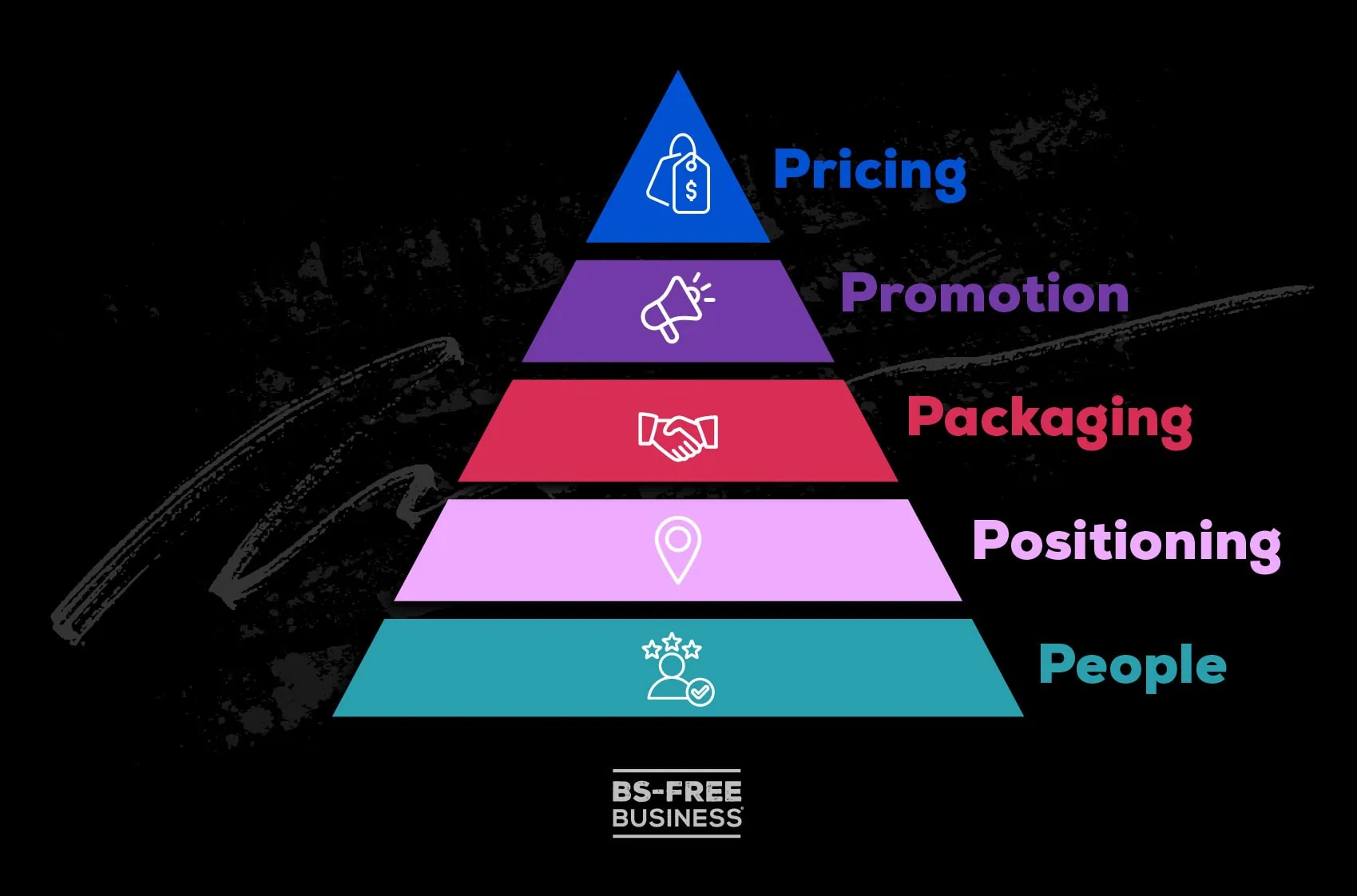
If you’ve studied marketing, you may be familiar with the concept of the 4 Ps (product, price, place and promotion) conceptualized by E. Jerome McCarthy in 1960. That was my jumping-off point for the idea of the Strategy Stack, as the idea behind the 4 Ps is that they’re the foundations of marketing and are interdependent.
Strategy is about having a solid plan; for solo service providers, the 4 Ps don’t cover all the bases. You need the essentials like your people, positioning, and packaging.
That’s why I created the Strategy Stack—these are the strategic must-haves for your service business. You start with the foundational elements at the bottom and work your way up to the marketing efforts at the top. This structure ensures you build your business on solid ground, making it more sustainable and adaptable.
Here’s where the Strategy Stack shines: it directly challenges the lie that you don’t need to revisit the basics once you've nailed them.
This "set it and forget it" mentality is dangerous, especially as your business grows or the market shifts. These foundational elements need regular attention to keep your business on track.
A big problem is that too many solo business owners are focused on the wrong issues. They’re trying to fix problems too high up in the stack, like tweaking their marketing or pricing, when the real issue is much deeper.
For example, let’s say you’re a service provider and starting to feel like your clients aren’t thrilled with your work. You might assume you need to market more aggressively, maybe with a new campaign or raise your prices to justify your service level.
When you do that, you’re focusing on the wrong layer of the stack. Instead of fixing your marketing or pricing first, you need to return to the foundation and revisit how you deliver your service.
Maybe your Packages need to be clearer or better structured, or maybe your Positioning has become outdated, and your People aren’t sure exactly what problems you solve for them anymore.
I see this happen all the time. People get stuck trying to “fix” their marketing or pricing without addressing how they deliver their service. They spend weeks tweaking landing pages or social media posts, but the real issue lies in how their services are structured or their position in the market.
Without going back to the People layer—redefining who they’re serving, how they’re serving them, and why their service matters—they’ll continue to hit roadblocks.
The Strategy Stack helps you avoid this cycle of spinning your wheels. Instead of jumping to the higher layers and hoping for a quick fix, it encourages you to revisit the foundational elements that constantly need updating.
When you revisit the basics—your target audience, service packages, and positioning—you ensure your business is aligned with your evolving goals and market needs.
Going back to the bottom of the stack and strengthening those lower layers gives your business a solid foundation to build on, no matter how much you grow.
Now, let’s break down the layers of the Strategy Stack in detail.
People: The Power of Precision
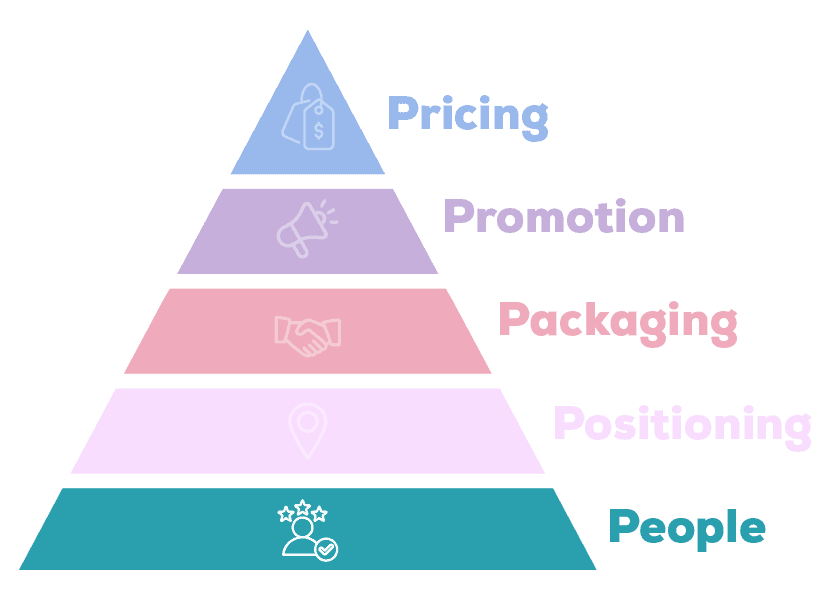
Let’s kick things off at the bottom of the pyramid: People. And when I say People, I’m talking about your market and, more importantly, your target client.
It’s no secret that the clearer you are on your target audience, the easier it is to build a successful business. When you’re specific, stop wasting time on clients who aren’t a good fit and start attracting those who genuinely need what you offer.
You’ve heard advice about niching a million times, and I’m not going to belabour that here, as there’s more than one way to niche your business. (I’m going to dive into the power of a micro niche in an upcoming episode.)
At the highest level, you need to get more specific and identify the problems you solve for a distinct group of people. Stop trying to cast such a wide net. “Women entrepreneurs” is nowhere near specific enough.
If you’re hesitant, a small, specific market means it’s easier to position, package, price and promote your services.
Rather than saying you work with "creative entrepreneurs," narrow it down to "freelance graphic designers who struggle with time management."
See how precise that is? It’s a subset of creative entrepreneurs, and by getting specific, you can refine your marketing and services to appeal to their unique challenges directly. Now, you’re not just another consultant for creatives but someone who truly understands their struggles.
But don’t stop there. Go deeper.
You need to learn everything you can about your target client. What do your ideal clients care about? What are their pain points, desires, and goals?
Remember, your target clients evolve as the market and your business grows. Just because you defined your ideal client a few years ago doesn’t mean they’re still the same today. The market has changed so much in the last two to three years that you can’t afford to assume that your audience's needs, desires, or challenges haven’t shifted.
If you’re not revisiting your target market, you risk working with clients who no longer align with your expertise. Refining these details ensures you work with the right clients and stay relevant.
Positioning: Get Clear, Get Clients
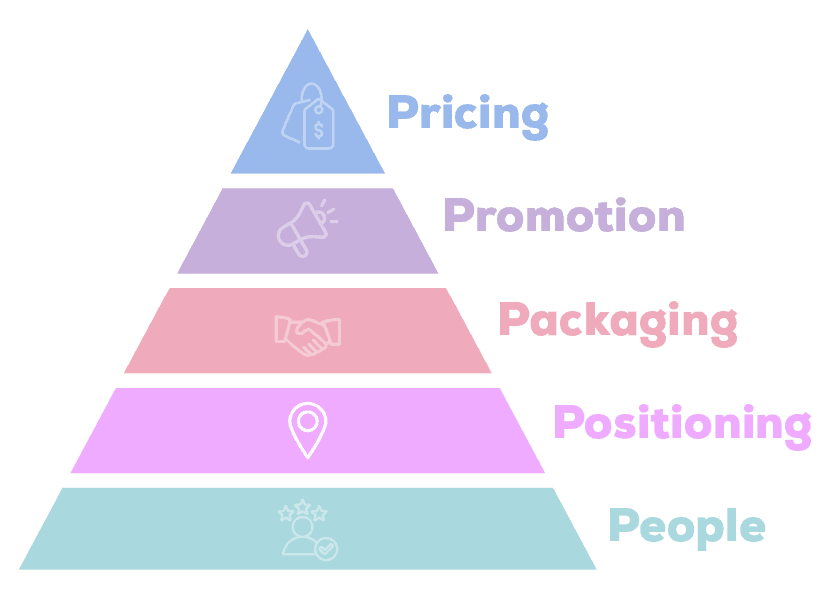
Now, let’s talk about how you position yourself.
Positioning is how you present your services and value to the world. It’s about what makes you stand out in a crowded market. Think of it as your unique value proposition (UVP), which makes you different from everyone else who does what you do.
Positioning is how you become the person for a specific need. And when you’re positioned well, people won’t just buy from you—they’ll feel like they need you.
As a solo service provider, you must clearly and consistently communicate what makes you an expert so you’re seen as the go-to person for something specific. People pay for expertise, and the more clearly defined your expertise is, the easier it is for them to identify that you’re the best person to help them.
Let’s say you’re a client experience consultant. Instead of being a "client experience consultant for businesses," position yourself as “I help boutique law firms improve client retention and referrals without overburdening their teams.”
In this example, you’d want to highlight your years of experience working in law firms and showcase your deep understanding of their unique challenges in client communication. Share relevant case studies or testimonials from law firms you've successfully helped, demonstrating your ability to solve their specific problems.
It’s worth noting that what worked at the start of your business may no longer resonate as you refine your services and get clearer on your expertise. Regularly refining and updating your positioning ensures you’re speaking directly to the clients who need what you offer now.
Updating your positioning isn’t just about changing your message—it’s about accurately reflecting the value your business offers as it evolves.
Packaging: More Than Just a List of Tasks
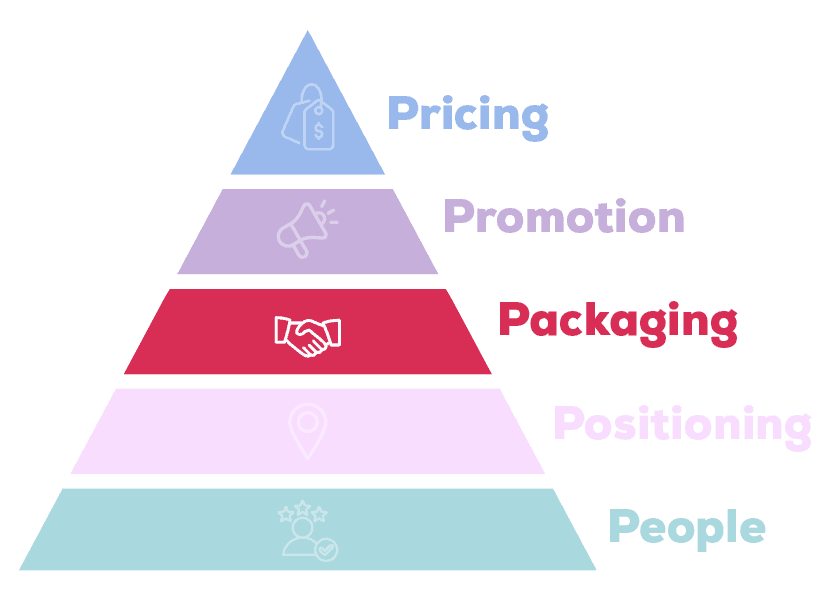
When packaging your services, it’s crucial to realize that it’s not just about throwing together a list of tasks or slapping a price tag on something.
Far too often, I see people jumping straight into creating a package without considering the foundation of their business—their people and positioning.
This is a classic mistake! When you start with packaging without clearly defining who you’re serving and how you’re positioning yourself, you end up with random services that lack focus and direction.
When that happens, you risk having generic packages that bring in poor-fit clients or offers that you struggle to sell as no one is interested.
Packaging is in the middle of the Strategy Stack for a reason. It’s the bridge between your services and clients, and aligning with your target market's needs and business goals is essential. It’s about more than just listing tasks, a scope of work, and a price.
A well-designed package is a strategic decision that considers your client's challenges, the outcomes they want to achieve, and how you can deliver those results without overloading yourself. Packaging your services requires a balance of art and strategy, ensuring that you’re offering something valuable to the client, manageable for you, and profitable for your business.
There are multiple ways to deliver your services, from retainers to flat rate projects to VIP days or intensives to billing by the hour. There’s no “right” way to do this, and not every delivery model works for every business or client.
For instance, let’s take a VIP day—many people love offering a single day of intense focus with a client, but that doesn’t mean it’s the right fit for everyone.
For some clients, a VIP day might feel rushed, or they might need time to reflect and implement between sessions. And for some business owners, offering a VIP day can be draining, especially if they’re not energized by intense, back-to-back work.
This is why aligning the delivery method with your strengths and clients' needs is crucial. It’s about finding the right way to package your service so it’s both saleable and sustainable.
Finally, avoid overcomplicating your packages by creating an “offer suite” with layers of extraneous services. I will discuss this in more detail in the next episode, but your packages can and should be simple.
You’ll always be better off focusing on one or two services you know you can sell reliably and consistently.
Promotion: Your Marketing Defines Your Packages and Prices
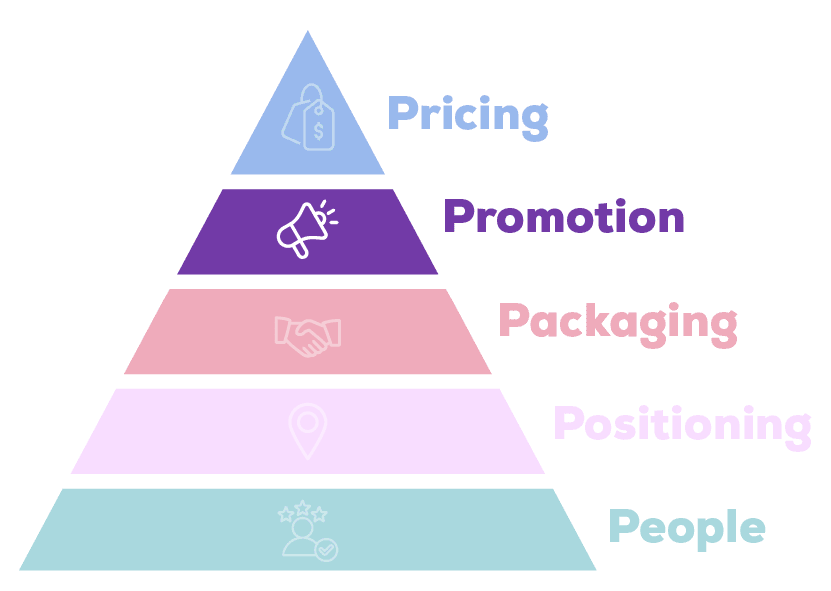
Your promotion (aka your marketing) directly influences the types of packages you can sell and how you can price them, which is why packaging sits in the middle of the Strategy Stack.
The type of promotion you're willing and able to do will dictate how you structure your services. Many solo service providers don’t enjoy marketing, and that’s okay, but you need to align your service model with your ability and willingness to promote.
If you rely on content marketing or referrals, you’ll need a clear, easy-to-understand package and a good fit for those channels. If you’re doing one-on-one sales or high-touch networking, you might be able to offer a more customized, premium-priced package.
Without understanding the promotional channels you’ll be using, you can easily create packages that are too complex, vague, or priced too high or too low for your plan.
Returning to the VIP day example, it’s appealing because of its high-ticket potential, but it's promotion-heavy. To fill these days consistently, you need to attract new clients every month, which requires constant marketing.
If you don’t enjoy marketing or don’t have a reliable system in place, this can quickly become a challenge. If you’re not prepared for the marketing grind, a VIP day might not be the right fit for your business.
On the flip side, if you’re someone who really enjoys marketing and it brings you clients reliably and doesn’t want ongoing client commitments the VIP Day model may be better for you than retainers.
The key isn’t for you just to do random acts of marketing but to promote with purpose by aligning it with your people, positioning and packaging. Your promotion needs to be genuinely strategic; otherwise, it will run you into the ground, no matter how much you like marketing.
Pricing: Test, Refine, and Adjust to Stay Relevant
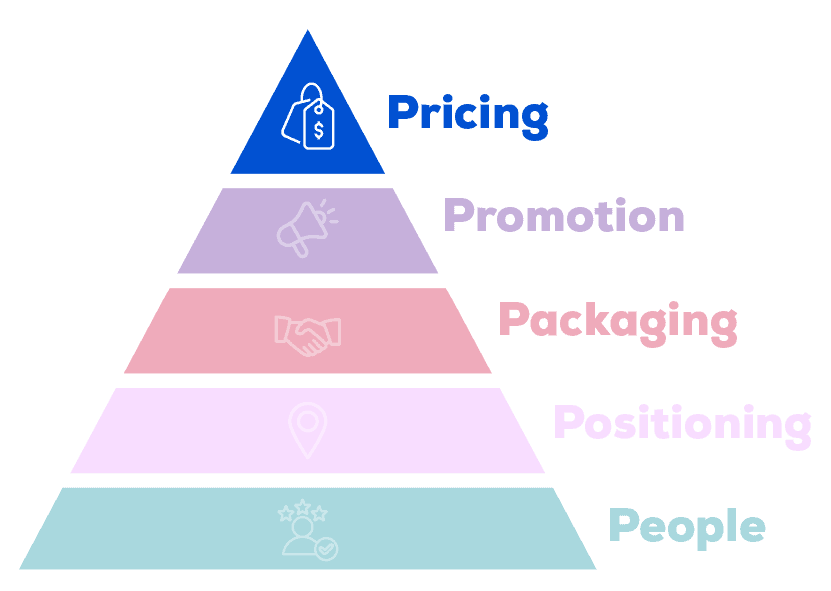
Pricing is the last layer of the Strategy Stack and is the culmination of the four Ps that come before it. After all, your pricing directly reflects your value, and how you position yourself, package your services, and promote them all play a critical role in determining what you can charge.
Many solo service providers undervalue their services, thinking they need to “compete” on price. However, pricing too low sends the message that your services are of low quality or may bring in bargain hunters. Pricing that is too high without the proper positioning and promotion to back it up will scare potential clients away.
The key is to find that sweet spot where your price aligns with the value you deliver and matches your positioning, packaging, and promotion. It’s not about charging what you think you’re “worth” but about pricing based on the demand for your service, the perception of your value and the results you can provide.
Finding that sweet spot involves a bit of testing. As you refine your offerings and gain more experience, you’ll find that your price point may shift. At first, you might test a lower price to build your portfolio or gain testimonials. Over time, as your credibility grows, you can increase your pricing to reflect your expertise and the tangible results you offer.
As the market shifts, consumer expectations and needs evolve, so your pricing strategy may need to follow suit. What worked last year may not work today, especially if there have been significant changes in your industry, target audience, or the competitive landscape.
If your client’s needs change or the market demands more specialized or high-touch services, your pricing needs to reflect that shift. This is why revisiting your entire Strategy Stack regularly is so important.
Also, suppose your pricing no longer aligns with your market or evolving services. In that case, it may be time to go back to the bottom of the stack—reevaluate your target audience, adjust your positioning, refine your packages, and adjust your pricing accordingly.
A great example is how my corporate budgets have shifted and are tighter these days. So if that’s your audience, and you want to keep charging the same or even higher prices, you’ll need to adjust the rest of your Strategy Stack. This means taking a step back to reassess your target audience, refine your positioning, tweak your packages, and ensure everything aligns with what your clients are willing to invest today.
When your pricing strategy is aligned with your positioning, your marketing efforts, and the value you deliver, you’ll land clients who respect your expertise and are willing to invest in the results you provide.
Stacking Your Strategy for a Peaceful and Profitable Service Business

Your business constantly evolves; if you treat it as static, you may find yourself stuck or struggling.
The Strategy Stack helps you check in on your foundations—your people, positioning, packaging, promotion, and pricing—to keep your business simple, streamlined, and running smoothly. By focusing on the fundamentals, you build a business that’s not flashy but steady and boring in the best possible way.
Before we go, I want you to reflect on your Strategy Stack. Take a moment to reflect on your business. Are all five layers in place? Which one needs your time and attention?
Sustainable growth is about continuously refining what’s working and cutting out what isn’t. Keep your Strategy Stack sharp and aligned, and your business will be ready to handle whatever comes next.